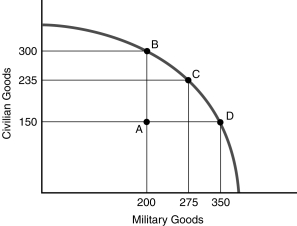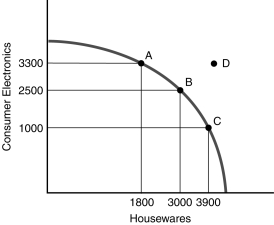Correct Answer

verified
Correct Answer
verified
Short Answer
The opportunity cost of making a decision is the _________ forgone alternative.
Correct Answer

verified
Correct Answer
verified
Multiple Choice
 Figure 1.2
-What is happening if the economy moves from point A to point D in Figure 1.2?
Figure 1.2
-What is happening if the economy moves from point A to point D in Figure 1.2?
A) Resources that were initially being used to produce military goods are now being used to produce civilian goods.
B) Resources that were initially being used to produce civilian goods are now being used to produce military goods.
C) Previously unemployed resources are now being used to produce more civilian goods.
D) Previously unemployed resources are now being used to produce more military goods.
F) C) and D)
Correct Answer

verified
Correct Answer
verified
True/False
Economic theory asserts that human behavior is always unpredictable.
B) False
Correct Answer

verified
Correct Answer
verified
Multiple Choice
The goal of economic theory is to
A) help people make wise investments.
B) advise businesses on how to market their products well.
C) advise businesses on how to make good products.
D) predict how people will react to changes in the circumstances surrounding how they go about satisfying their wants.
F) A) and B)
Correct Answer

verified
Correct Answer
verified
Multiple Choice
 Figure 1.3
-What would be TRUE of a movement from point C to point B in Figure 1.3?
Figure 1.3
-What would be TRUE of a movement from point C to point B in Figure 1.3?
A) The output of housewares would fall by 1200 units and the output of consumer electronics would increase by 800 units.
B) The output of housewares would fall by 900 units and the output of consumer electronics would increase by 2500 units.
C) The output of housewares would fall by 900 units and the output of consumer electronics would increase by 1500 units.
D) The output of housewares would fall by 900 units and the output of consumer electronics would increase by 1000 units.
F) A) and B)
Correct Answer

verified
Correct Answer
verified
True/False
Opportunity costs do not arise in conjunction with health care decisions.
B) False
Correct Answer

verified
Correct Answer
verified
Short Answer
Cost is always a _________ opportunity.
Correct Answer

verified
Correct Answer
verified
True/False
Economics is the study of how to invest wisely.
B) False
Correct Answer

verified
Correct Answer
verified
True/False
Opportunity costs do not arise in conjunction with political decisions.
B) False
Correct Answer

verified
Correct Answer
verified
Multiple Choice
"Using economics" means
A) saving money.
B) eliminating scarcity.
C) ignoring opportunity costs.
D) making choices.
F) C) and D)
Correct Answer

verified
Correct Answer
verified
Multiple Choice
 Figure 1.3
-What would be TRUE of a movement from point A to point C in Figure 1.3?
Figure 1.3
-What would be TRUE of a movement from point A to point C in Figure 1.3?
A) There would be a gain of 3900 units of housewares at the cost of 3300 units of consumer electronics.
B) There would be a gain of 3900 units of housewares at the cost of 800 units of consumer electronics.
C) There would be a gain of 2100 units of housewares at the cost of 3300 units of consumer electronics.
D) There would be a gain of 2100 units of housewares at the cost of 2300 units of consumer electronics.
F) A) and C)
Correct Answer

verified
Correct Answer
verified
True/False
Moving from point to point along the production possibilities curve means that the economy is trading off production of one good for production of another.
B) False
Correct Answer

verified
Correct Answer
verified
Short Answer
We live with unlimited wants in a world of _________ resources.
Correct Answer

verified
Correct Answer
verified
Multiple Choice
Suppose you have four choices-go to a movie, read a book, watch television, or go to a concert. You choose to go to a movie. The opportunity cost of the movie is
A) the value of the book not read.
B) the value of the television program not watched.
C) the value of the concert that you didn't attend.
D) the value of the activity that you would have selected if you hadn't gone to the movie.
F) B) and C)
Correct Answer

verified
Correct Answer
verified
True/False
Every choice involves an opportunity cost.
B) False
Correct Answer

verified
Correct Answer
verified
True/False
Does the assumption of rational self-interest imply that society would be better off if more decisions about what to consume were made by government officials, rather than by individuals themselves?
B) False
Correct Answer

verified
Correct Answer
verified
Multiple Choice
 Figure 1.2
-What is happening if the economy moves from point D to point C in Figure 2?
Figure 1.2
-What is happening if the economy moves from point D to point C in Figure 2?
A) Resources that were initially being used to produce military goods are now being used to produce civilian goods.
B) Resources that were initially being used to produce civilian goods are now being used to produce military goods.
C) Previously unemployed resources are now being used to produce more civilian goods.
D) Previously unemployed resources are now being used to produce more military goods.
F) A) and B)
Correct Answer

verified
Correct Answer
verified
Multiple Choice
Economics is best defined as the
A) study of self-interest.
B) study of how people make choices to satisfy their wants.
C) study of how government can most efficiently raise funds by taxation.
D) process by which goods are sold in free markets.
F) None of the above
Correct Answer

verified
Correct Answer
verified
Multiple Choice
 Figure 1.3
-If the economy moves from point B to point C in Figure 1.3, the output of housewares will rise by 900 units at an opportunity cost of _________ units of consumer electronics.
Figure 1.3
-If the economy moves from point B to point C in Figure 1.3, the output of housewares will rise by 900 units at an opportunity cost of _________ units of consumer electronics.
A) 3300
B) 2300
C) 2500
D) 1500
F) A) and C)
Correct Answer

verified
Correct Answer
verified
Showing 41 - 60 of 131
Related Exams